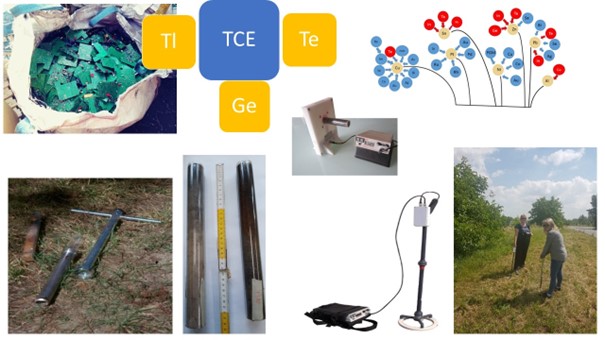The development of electrical and electronic industry, rapid consumption and "ageing" of the equipment entail the necessity of regular replacement, which increases the amount of electrical and electronic waste (called just e-waste or WEEE). E-waste is a specific type of waste, that is a source of PTE (Potentially Toxic Elements), including TCE (Technology Critical Elements). The implementation of the project allowed to obtain original results of comprehensive environmental and material research, including: determining and comparing the content of elements, including critical elements (TCE), in soils in the areas surrounding various WEEE processing plants in Katowice, Krakow and Lublin; as well as the speciation of germanium, thallium and tellurium in soils. As part of the project, the quantitative and qualitative content of Ge, Te and Tl and other PTE in the soil profile was identified, as well as the methodology of soil sample preparation and determination of ionic forms of Ge, Te and Tl using the hyphenated HPLC-ICP-MS technique. Their mobility was also tested by sequential chemical extraction. In this study, the soil magnetometry method was used for the first time to mark out the soil sampling sites in relation to the TCE elements. The soil magnetometry method based on in situ measurements of soil magnetic susceptibility is a good tool for determining the range of dust emission, as well as the location of sampling sites (places with high magnetic susceptibility values, and therefore with high accumulation of technogenic magnetic particles together with PTE and TCE). Chemometric studies showed a strong positive correlation between the content of critical elements and the magnetic susceptibility and other elements present in the soil. Storage, processing and recycling of electrowaste increases the pollution with toxic and critical elements in the environment. The soil is the most susceptible to the accumulation of pollutants and is an indicator of many years of human activity. It has been shown that the increase in the content of Ge, Tl and Te in the soil is influenced by such factors as: the type of soil in the area surrounding the WEEE plant, the prevailing winds direction in this area, topography, as well as the duration of waste processing. A strong correlation was found between the length of the electrowaste processing time and the concentration of TCE in the soil. The highest concentration of TCE was found in the areas surrounding the WEEE plant in Katowice, then in Krakow, and the shortest operating plant in Lublin had the lowest impact on the environment. Our research showed that the dominant forms in soil are Tl(I), Ge(IV) and that the concentrations of both tellurium forms (Te(IV) and Te(VI)) were comparable or the concentration of the reduced form of tellurium quantitatively exceeded the content of Te(VI). Sequential chemical extraction of critical elements allowed to determine the mobility of Ge, Tl, Te in soils, which, combined with the speciation analysis of the ionic forms of these elements, significantly expanded the knowledge on this subject at the international level. The study of the elements content in the soil profile showed that the highest concentration of TCE was found in the topsoil, which clearly indicates an anthropogenic rather than a geogenic origin of these elements. Our research has shown that although in the areas surrounding WEEE processing plants an increase in the concentration of TCE in soils is observed, these elements are bound by soils and occur in immobile forms, poorly accessible to plants.
Selected electronic elements (solar lamps, solar cells, LED TV screens, LCD screens, photoresistors, photodiodes, phototransistors) being the carriers of Ge, Te and Tl were analyzed. These electronic elements were ground, a sieve analysis was performed and the content of elements in individual fractions was determined. This issue is particularly important because the WEEE recycling processes (crushing, grinding, and even collection and transport operations) can lead to dispersion and migration of TCE pollutants to the environment. It was found that Ge, Te and Tl are concentrated in the finest fractions of ground e-waste and this favors their migration during their storage and processing.
The implementation of the project allowed for the publication of several articles of international scope with high IF, several works are in preparation. The research results were widely presented at national and international conferences. The created and validated methodologies for determining the total TCE content and their species in soils were the project result. The project research has made a significant contribution to environmental engineering, analytical chemistry, metallurgy, soil science and geophysics.





